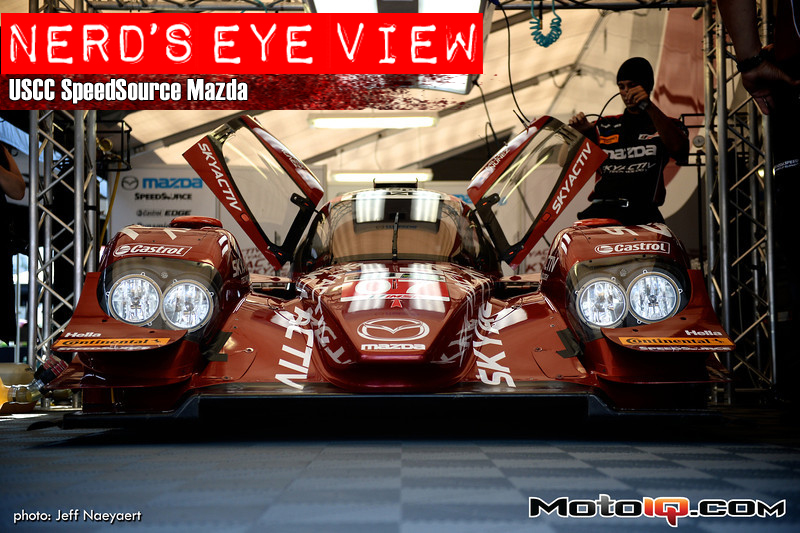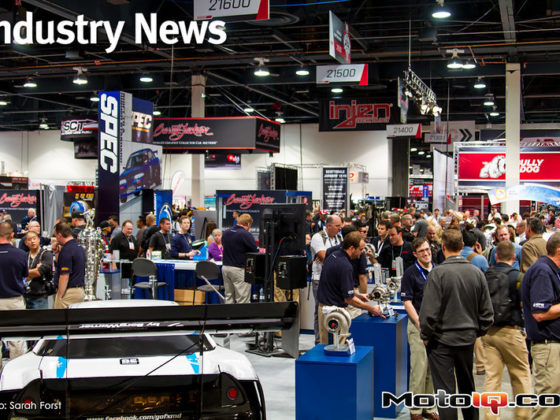,
 The transaxle in this prototype does more than just contain gears and a differential, it also acts as the mounting points for the majority of the rear suspension components. Like the front suspension, the rear shocks are mounted inboard and are activated via bell cranks. Linear potentiometers are used to datalog shock movement during testing. This data is then analyzed to better determine damper settings.
The transaxle in this prototype does more than just contain gears and a differential, it also acts as the mounting points for the majority of the rear suspension components. Like the front suspension, the rear shocks are mounted inboard and are activated via bell cranks. Linear potentiometers are used to datalog shock movement during testing. This data is then analyzed to better determine damper settings. Speaking of dampers, here are the DSSV 4-way adjustable shocks used on the SpeedSource Mazda. The red and blue topped cylinders are the adjustment knobs that control the amount of high and low-speed compression and rebound damping. Each setting affects the shocks' damping characteristics in a different way. And in case anyone isn't sure, high and low speed refer to the speed of the shock's shaft, not the speed of the car.
Speaking of dampers, here are the DSSV 4-way adjustable shocks used on the SpeedSource Mazda. The red and blue topped cylinders are the adjustment knobs that control the amount of high and low-speed compression and rebound damping. Each setting affects the shocks' damping characteristics in a different way. And in case anyone isn't sure, high and low speed refer to the speed of the shock's shaft, not the speed of the car. This is the car's rear anti-roll bar. This may look very different than the anti-roll bars on passenger cars, but it serves the same purpose using the same basic mechanical principles. When the car hits a bump and both the left and right shocks move at the same rate, the swaybar is mostly free to move fore and aft. However, during cornering when one shock wants to move more than the other it puts a torque on the vertical round bar. The bar acts as a torsional spring to resist this movement since it takes a certain amount of torque to twist the bar a certain number of degrees. This spring constant (dictated by the diameter, length, and material of the bar) and the torque arm length determine the bar's “stiffness.” As is the case with most anti-roll bars, the stiffness is made variable by using different hole locations that change the length of the torque arm.
This is the car's rear anti-roll bar. This may look very different than the anti-roll bars on passenger cars, but it serves the same purpose using the same basic mechanical principles. When the car hits a bump and both the left and right shocks move at the same rate, the swaybar is mostly free to move fore and aft. However, during cornering when one shock wants to move more than the other it puts a torque on the vertical round bar. The bar acts as a torsional spring to resist this movement since it takes a certain amount of torque to twist the bar a certain number of degrees. This spring constant (dictated by the diameter, length, and material of the bar) and the torque arm length determine the bar's “stiffness.” As is the case with most anti-roll bars, the stiffness is made variable by using different hole locations that change the length of the torque arm. Carbon-carbon brakes from AP Racing quickly slow down the SpeedSource Mazda lap after lap. These brakes feature hugely thick rotors and 6-piston calipers. Both of these features help distribute heat over a larger area/volume to keep the rotors and pads in the correct temperature range for optimum performance and life while keeping the fluid from overheating.
Carbon-carbon brakes from AP Racing quickly slow down the SpeedSource Mazda lap after lap. These brakes feature hugely thick rotors and 6-piston calipers. Both of these features help distribute heat over a larger area/volume to keep the rotors and pads in the correct temperature range for optimum performance and life while keeping the fluid from overheating.


